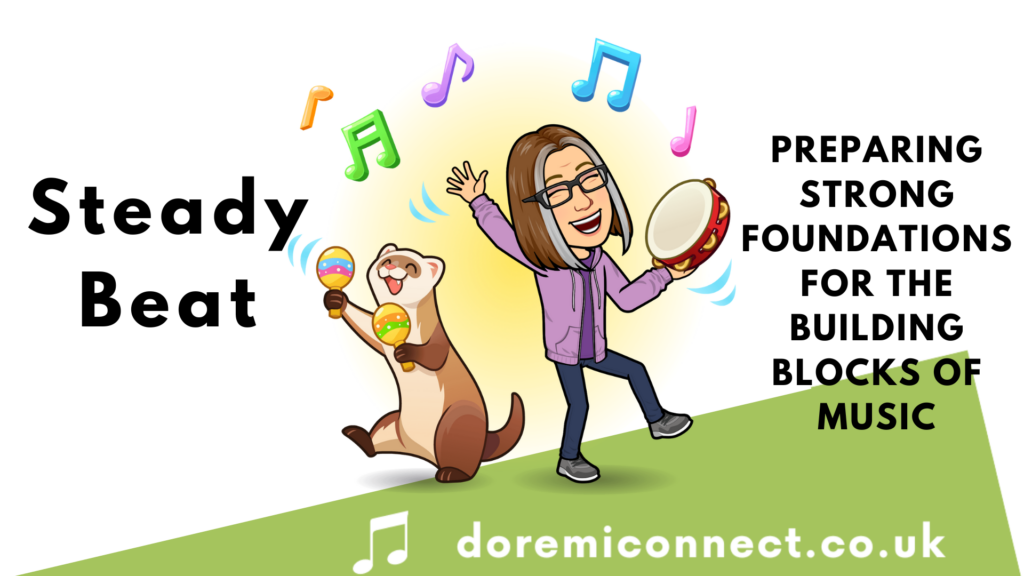Steady Beat: Preparing the Foundations for the Building Blocks of Music

Why is Steady Beat so important?
Developing Steady Beat is so important. It helps build strong foundations upon which to build the other important elements of music. If our students can’t keep a steady beat, it can be like trying building on sand when teaching other musical elements such as rhythm!
Rhythm is the pattern of sounds in relation to the beat. Therefore, before we can effectively teach rhythm, students need a clear sense of steady beat.
Infants from birth are rhythmically tied to the vocal and body rhythms of those around them. Keeping a steady beat is an abstract concept and while children will likely have their own beat, they need to learn to keep the beat together or move to somebody else’s beat.
Although seemingly simple, tapping to a beat is a specialised, complex process that challenges many parts of the brain. This is why it is important to guide the children in experiencing steady beat and give them a clear sense of it carefully planned stages: we need to prepare steady beat.
Thankfully, taking a Kodály inspired approach means we can give our students a clear and robust understanding of steady beat with singing and games.
Experience Steady Beat Together
First the students need to feel it together. They can sing any song and rock to it. For babies the adult can bounce them on their knees to help them to feel it. Obviously, we cannot do this with older children but lycra is a very valuable tool (hint – get four-way stretch lycra. Mine is 1.5 x 2m). The students can hold on as they bounce the lycra to the song. The stretchiness gives them freedom to move and they can help each other feel the steady beat. An alternative is to hold hands and swing, but they don’t always want to hold hands and some children are stronger than others!
My favourite is Zoom Zoom Zoom; put a toy in the middle and swing the toy to the beat. At the end count down “5, 4, 3, 2, 1!” and zoom the toy up into space. You can also assess how well they keep a steady beat during the 5, 4, 3, 2, 1 countdown (more on that later).
Experience Steady Beat Physically Whilst Stationery
The students need to physically experience beat independently. This could include experiencing it while seated for example, a hammering action to Cobbler Cobbler or chopping action to Chop Chop. Experiencing it with a variety of different songs and rhymes of different metres is a great idea because the students gain different experiences of steady beat from an early stage. The students will get a visual cue from you.
Another way to experience steady beat independently is by sitting in a circle and tap the knee of the student next to them. Students can experience the beat physically without moving around.
Apple Tree is a great song for experiencing steady beat in a circle. One game to go with this song is to pass bean bags (apples) around a circle to the beat. The great thing about bean bags is they are easy to grab and if dropped they just fall on the floor. Another easy-to-pass, non-rolling alternative is a balled-up piece of paper. Passing a clap around the circle is a similar action to passing a bean bag, although a bit harder than passing a bean bag.
Experience Steady Beat Physically in Motion
Walking, Basically!
A warning: little legs walk faster than big legs so the tempo of your song will need to be faster. A tip: ask them to walk first and match their walking pace.
You could walk in a free space to art music. I like Elgar’s Pomp and Circumstance because I’m in Worcestershire but you can choose any music with a strong beat.
You can also walk in a line to a song or rhyme such as Engine Engine Number 9. As well as walking, arms can move like a train to the beat.
The walking can also be in a circle. Bear in mind that walking in a circle is hard! To be able to effectively walk in a circle the children need to hold hands and walk with their body twisted. That’s why co-operbands or giant scrunchies are great! Some people choose to make their own. Just like with the lycra, the students can hold onto the co-operband like a handrail and stay in a circle.
Have you played any of these games in your classroom or music lessons? I’d love to hear how you found it! Which songs, rhymes or games do you like to use?
[…] To prepare rhythm, we need to go through the same steps we went through with beat but with rhythm! If you haven’t read my blog about steady beat, catch-up here. […]